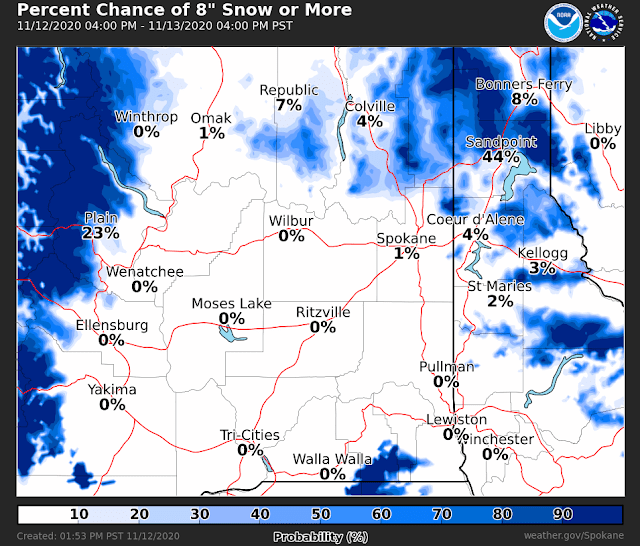For the past few days several of the long range forecast models have been advertising a pattern change starting around Thanksgiving, and persisting through at least early December. What does this mean? We will get to that in a little bit.
Outlook through Thanksgiving Eve
First, let's discuss the weather leading up to Thanksgiving. This graphic sums it up
After a dry weekend, the potential exists for light snow Monday morning in some areas which could make for a slick morning commute. Then Tuesday into Wednesday another system moves in for more unsettled weather especially over the mountain passes. If you do have pre-Thanksgiving travel plans keep this in mind. Here is what the weather pattern looks like for Tuesday and Wednesday - as this will provide a nice comparison for what may lie ahead after that.
 |
| 12z Nov 20th GEFS Model forecast of 500mb heights and anomaly valid 4 AM PST Nov 25th, 2020 |
Note the cooler (blue) colors over our region as a weather system is passing through.
Thanksgiving onward
Starting on Thanksgiving and going through the rest of November, we notice a change in the weather pattern according to this latest model ensemble forecast from the US GEFS Model.
 |
| 12z Nov 20th GEFS Model forecast of 5 day averaged 500mb heights and anomaly valid Nov 26-Dec 1st, 2020 |
What we can see is a zonal (west to east) flow pattern taking over the Pacific, with a milder west to southwest flow for our region. The pattern energizes further going into early December based on this ensemble model output.
 |
| 12z Nov 20th GEFS Model forecast of 5 day averaged 500mb heights and anomaly valid Dec 1st-6th, 2020 |
But this is just one model ensemble system (US GEFS). Since we are 12-16 days out into the future, we need to examine other ensemble systems to gage confidence in this solution.
Here is the Canadian version valid Nov 30th-Dec 5th
 |
| 12z Nov 20th GEPS Model forecast of 5 day averaged 500mb heights and anomaly valid Nov 30-Dec 5th, 2020 |
Pretty close agreement which increases our confidence. Mild southwest flow very prevalent from this solution. Another ensemble system, European (not shown), agrees with this idea. Thus confidence is a little higher than typical for a 1-2 week prediction for this pattern to set up.
Here is a closer look at a typical jet stream setup with this pattern, with this specific model solution valid Dec 3rd.
 |
| 12z Nov 20th GEFS Model forecast of 500 mb heights and winds valid 4 am PST Dec 3rd, 2020 |
This shows the jet stream north of our area, which is a mild pattern. This is especially true over Central Canada with the influx of mild Pacific air. Below is the US GEFS predition of temperature anomalies at 850 mb (~4500 feet MSL).
 |
| 12z Nov 20th GEFS Model forecast of 850mb temperature anomalies valid Dec 1-6th, 2020 |
Note no large cold anomalies anywhere close to our region. Note this pattern can bring inversions which could hold down temperatures in some areas of the Inland NW. And here is the Canadian version, really going for the mild temps Nov 30th-Dec 5.
 |
| 12z Nov 20th GEPS Model forecast of 850mb temperature anomalies valid Nov 30th-Dec 5th, 2020 |
What do the CPC outlooks suggest? Here is the outlook issued November 20th valid Nov 28-Dec 4th.
 |
| Climate Prediction Center 8-14 day temperature (left) and precipitation (right) outlook issued Nov 20th valid Nov 28th-Dec 4th, 2020 |
Elevated odds of warmer than normal temperatures, with about normal precipitation.
You may be asking, what is up with these milder temperatures, aren't we in a La Nina Winter? Why yes we are, but it is not uncommon to have atmospheric patterns change since La Nina is only one factor that influences our weather. So don't expect this pattern to last forever.


































